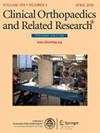Chronic Ankle Instability Is Associated With Smaller Sensorimotor Deficits and Greater Integrity of the Superior Cerebellar Peduncles With Aging.
IF 4.2
2区 医学
Q1 ORTHOPEDICS
引用次数: 0
Abstract
BACKGROUND Chronic ankle instability is associated with balance deficits and maladaptive cerebellar neuroplasticity across age groups. However, it remains unclear how aging and chronic ankle instability interact to influence these abnormalities, particularly in cerebellar structures that are essential for proprioception and motor coordination. This gap in understanding limits the development of age-specific rehabilitation strategies. QUESTIONS/PURPOSES This study aimed to: (1) determine the interaction effect of chronic ankle instability and aging on sensorimotor deficits, (2) assess whether this interaction is reflected in superior and inferior cerebellar peduncle microstructure changes, and (3) evaluate the correlation between altered cerebellar peduncle integrity and balance performance in patients with chronic ankle instability and a control cohort. METHODS Between August 2022 and January 2024, we screened 134 individuals for participation. Of these, 61% (82 of 134) were considered potentially eligible based on the inclusion criteria. One patient in the control group was excluded because of poor imaging quality. Ultimately, 60% (81 of 134) of participants were included in the final analysis, consisting of 51% (41 of 81) in the chronic ankle instability group (18 females, age 30 ± 6 years) and 49% (40 of 81) in the control group (17 females, age 29 ± 8 years). We collected participants' demographic information, clinical history, as well as clinical data, including Cumberland Ankle Instability Tool scores for self-reported instability and Tegner activity scores. All participants underwent the Y-balance test to evaluate sensorimotor deficits and diffusion-weighted imaging to assess the structure of the central nervous system. We focused on the superior and inferior cerebellar peduncles as regions of interest and performed both traditional diffusion tensor imaging and advanced neurite orientation dispersion and density imaging to evaluate the cerebellar white matter microstructure. Multivariable linear regressions with interaction terms were conducted to examine the interaction effects of chronic ankle instability and age on primary clinical outcomes (Y-balance test scores and diffusion tensor imaging/neurite orientation dispersion and density imaging outcomes). Correlation analyses between posteromedial reach distances on the Y-balance test and significant diffusion tensor imaging/neurite orientation dispersion and density imaging outcomes were performed within the chronic ankle instability and the control groups, respectively. In particular, we calculated a standardized beta coefficient (β*) for each regression model to facilitate comparison of effect sizes across variables to more easily judge which predictors contributed more substantially to the outcomes. RESULTS After controlling for potential confounding factors including sex, BMI, and Tegner activity scores, we found that although participants with chronic ankle instability generally had poorer dynamic balance, the group differences in anterior (β = 0.58 × 10-2 [95% CI 0.09 × 10-2 to 1.07 × 10-2]; β* = 1.11; p = 0.02), posteromedial (β = 0.74 × 10-2 [95% CI 0.10 × 10-2 to 1.38 × 10-2]; β* = 1.15; p = 0.03), and average Y-balance test scores (β = 0.56 × 10-2 [95% CI 0.02 × 10-2 to 1.10 × 10-2]; β* = 1.01; p = 0.046) were smaller in older participants. Similarly, we found that compared with controls, participants with chronic ankle instability generally had impaired nerve pathways in superior cerebellar peduncles, characterized by lower fractional anisotropy values and higher orientation dispersion index values. However, these structural differences were smaller among patients with older age, in fractional anisotropy (β = 1.96 × 10-3 [95% CI 0.09 × 10-3 to 3.82 × 10-3]; β* = 0.93; p = 0.04), and orientation dispersion index values (β = -1.41 × 10-3 [95% CI -2.49 × 10-3 to -0.33 × 10-3]; β* = -1.16; p = 0.01) compared with age-matched controls. In the superior cerebellar peduncles of the control group, participants with higher fractional anisotropy values had slightly greater posteromedial reach distances on the Y-balance test (r = 0.39; p = 0.01), suggesting better dynamic balance. In contrast, participants with higher orientation dispersion index values had slightly shorter posteromedial reach distances (r = -0.32; p = 0.04), suggesting poorer dynamic balance. CONCLUSION We found that the combination of older age and chronic ankle instability correlates with improved sensorimotor testing and potentially adaptive structural white matter changes in the cerebellum, particularly in the superior cerebellar peduncles. These findings suggest a possible age-related neural adaptation and highlight the need for future longitudinal and interventional studies to clarify these associations and explore whether age-specific rehabilitation strategies could be beneficial. LEVEL OF EVIDENCE Level III, prognostic study.随着年龄的增长,慢性踝关节不稳定与小脑上脚较小的感觉运动缺陷和更大的完整性相关。
背景:慢性踝关节不稳定与各年龄组的平衡缺陷和小脑神经可塑性不良有关。然而,目前尚不清楚衰老和慢性踝关节不稳定如何相互作用影响这些异常,特别是对本体感觉和运动协调至关重要的小脑结构。这种认识上的差距限制了针对特定年龄的康复策略的发展。问题/目的本研究旨在:(1)确定慢性踝关节不稳定和衰老对感觉运动缺陷的相互作用,(2)评估这种相互作用是否反映在小脑上、下小脑脚微观结构的变化上,(3)评估慢性踝关节不稳定患者小脑脚完整性改变与平衡表现之间的相关性。方法在2022年8月至2024年1月期间,我们筛选了134名参与者。其中,根据纳入标准,61%(134例中的82例)被认为可能符合条件。对照组1例因影像学质量差被排除。最终,60%(134人中的81人)的参与者被纳入最终分析,其中51%(81人中的41人)为慢性踝关节不稳定组(18名女性,年龄30±6岁),49%(81人中的40人)为对照组(17名女性,年龄29±8岁)。我们收集了参与者的人口统计信息、临床病史以及临床数据,包括自我报告不稳定性的Cumberland踝关节不稳定工具评分和Tegner活动评分。所有参与者都进行了y -平衡测试来评估感觉运动缺陷,并进行了弥散加权成像来评估中枢神经系统的结构。我们以小脑上、下小脑蒂为研究对象,采用传统的弥散张量成像和先进的神经突定向弥散和密度成像来评估小脑白质微观结构。采用多变量线性回归和相互作用项来检验慢性踝关节不稳定和年龄对主要临床结果(y -平衡测试分数和弥散张量成像/神经突取向弥散和密度成像结果)的相互作用。分别在慢性踝关节不稳组和对照组中,对y平衡测试的后内侧到达距离与显著弥散张量成像/神经突定向弥散和密度成像结果进行相关性分析。特别是,我们为每个回归模型计算了标准化的β系数(β*),以便比较变量之间的效应大小,从而更容易判断哪些预测因子对结果的贡献更大。结果在控制了包括性别、BMI和Tegner活动评分在内的潜在混杂因素后,我们发现,尽管慢性踝关节不稳定的参与者通常具有较差的动态平衡,但其前关节的组间差异(β = 0.58 × 10-2 [95% CI 0.09 × 10-2至1.07 × 10-2];β* = 1.11;p = 0.02),后内侧肌(β = 0.74 × 10-2 [95% CI 0.10 × 10-2至1.38 × 10-2];β* = 1.15;p = 0.03),平均y平衡测试成绩(β = 0.56 × 10-2 [95% CI 0.02 × 10-2至1.10 × 10-2];β* = 1.01;P = 0.046)。同样,我们发现,与对照组相比,慢性踝关节不稳定的参与者通常小脑上脚的神经通路受损,其特征是分数各向异性值较低,取向弥散指数值较高。然而,这些结构差异在年龄较大的患者中较小,在分数各向异性方面(β = 1.96 × 10-3 [95% CI 0.09 × 10-3至3.82 × 10-3];β* = 0.93;p = 0.04),取向色散指数值(β = -1.41 × 10-3 [95% CI -2.49 × 10-3至-0.33 × 10-3];β* = -1.16;P = 0.01)。在对照组的小脑上蒂中,各向异性分数值较高的参与者在y平衡测试中有稍大的后内侧到达距离(r = 0.39;P = 0.01),提示动态平衡较好。相反,取向弥散指数值较高的参与者的后内侧到达距离略短(r = -0.32;P = 0.04),表明动态平衡较差。结论:老年合并慢性踝关节不稳与感觉运动测试的改善和小脑(尤其是小脑上脚)潜在的适应性结构白质变化有关。这些发现表明可能存在与年龄相关的神经适应,并强调需要未来的纵向和干入性研究来澄清这些关联,并探索特定年龄的康复策略是否有益。证据等级:III级,预后研究。
本文章由计算机程序翻译,如有差异,请以英文原文为准。
求助全文
约1分钟内获得全文
求助全文
来源期刊
CiteScore
7.00
自引率
11.90%
发文量
722
审稿时长
2.5 months
期刊介绍:
Clinical Orthopaedics and Related Research® is a leading peer-reviewed journal devoted to the dissemination of new and important orthopaedic knowledge.
CORR® brings readers the latest clinical and basic research, along with columns, commentaries, and interviews with authors.

 求助内容:
求助内容: 应助结果提醒方式:
应助结果提醒方式:


